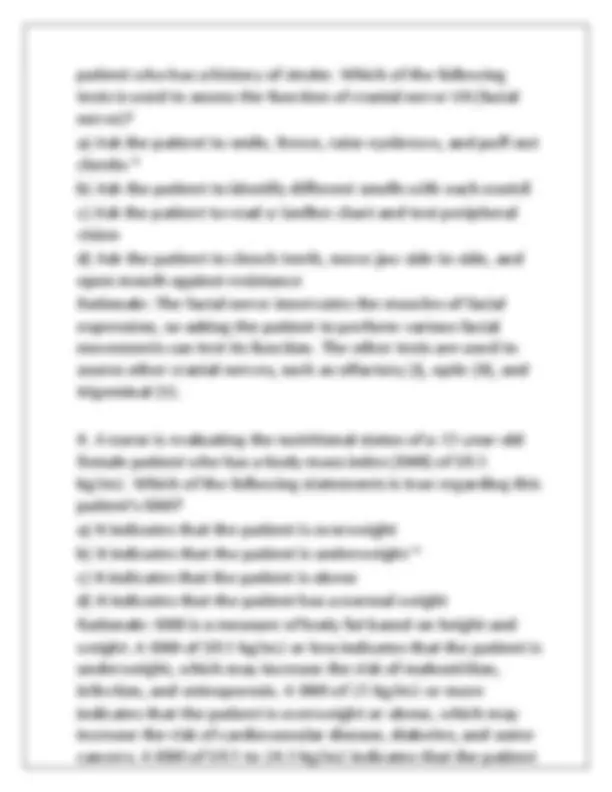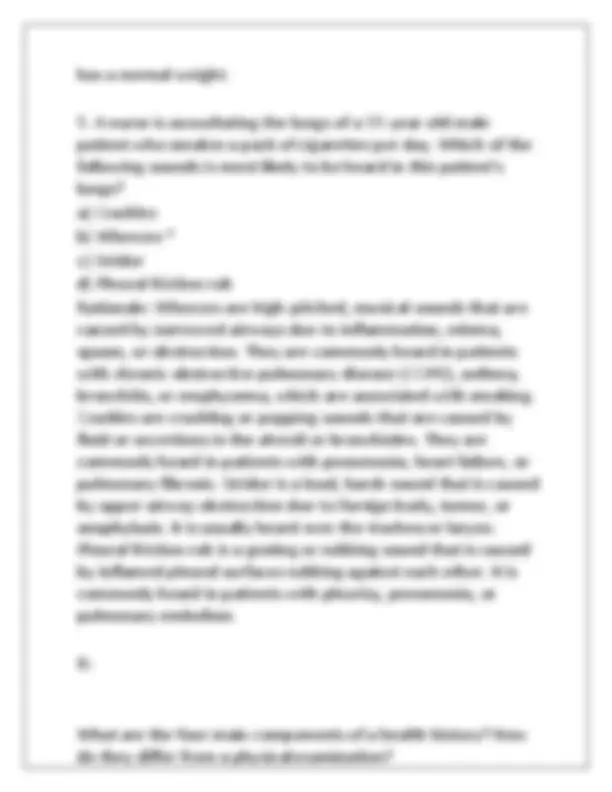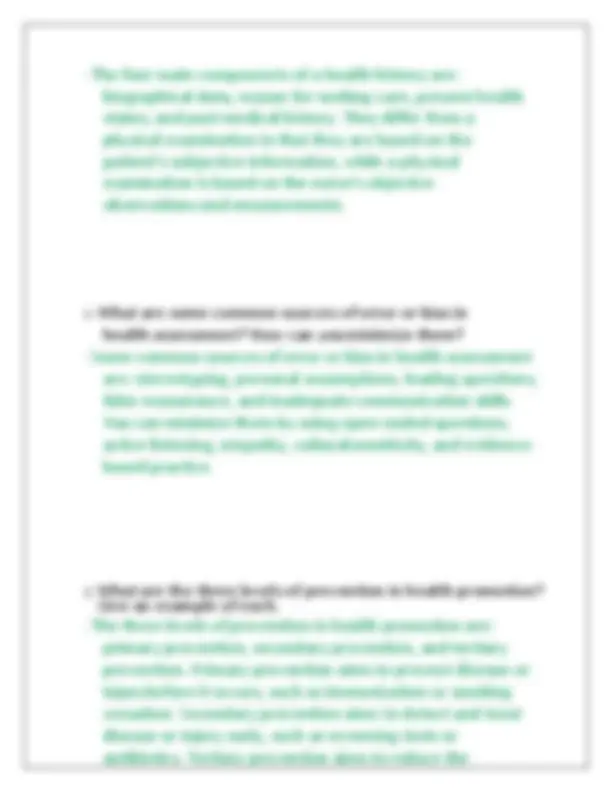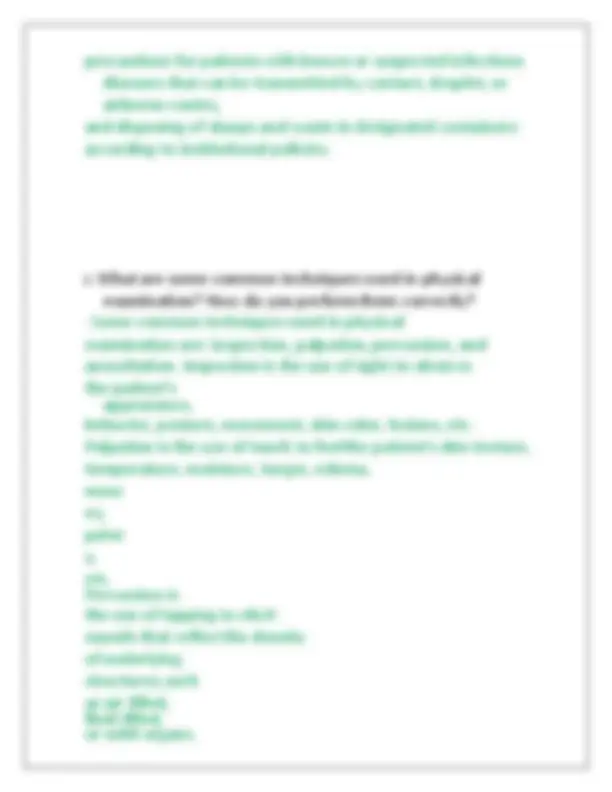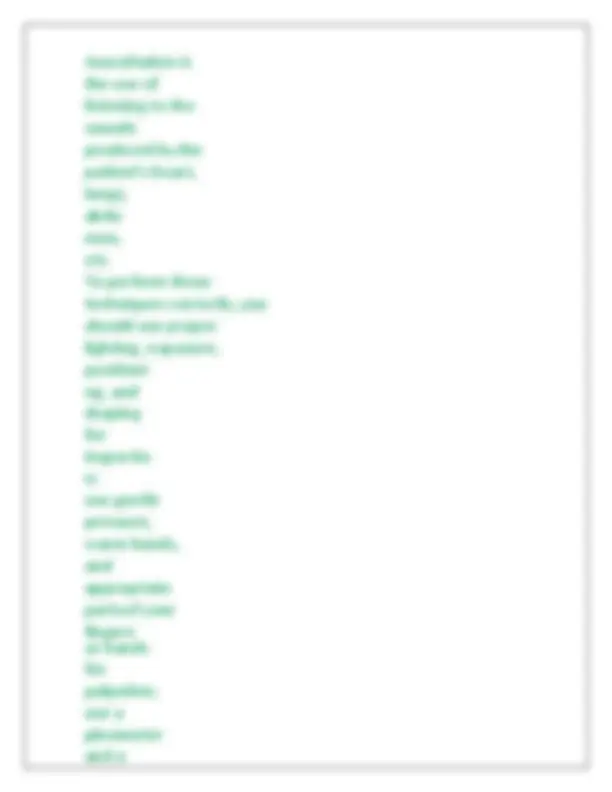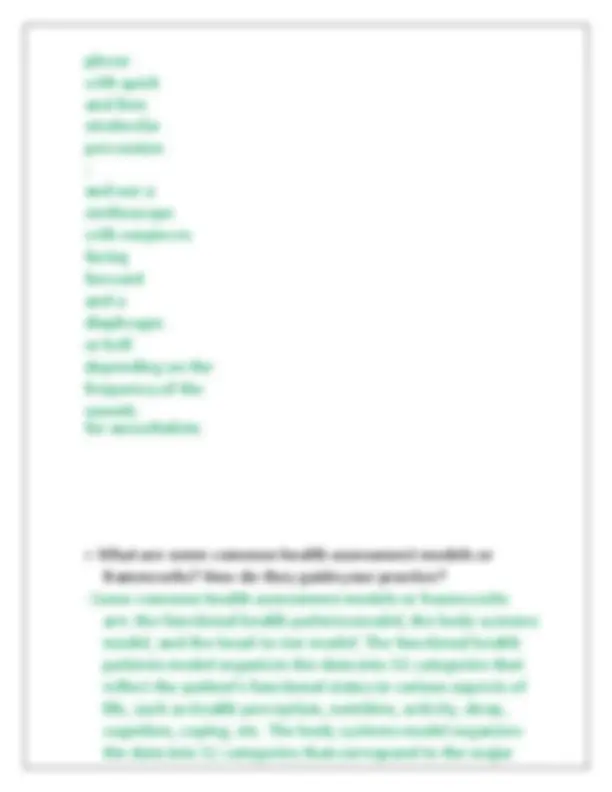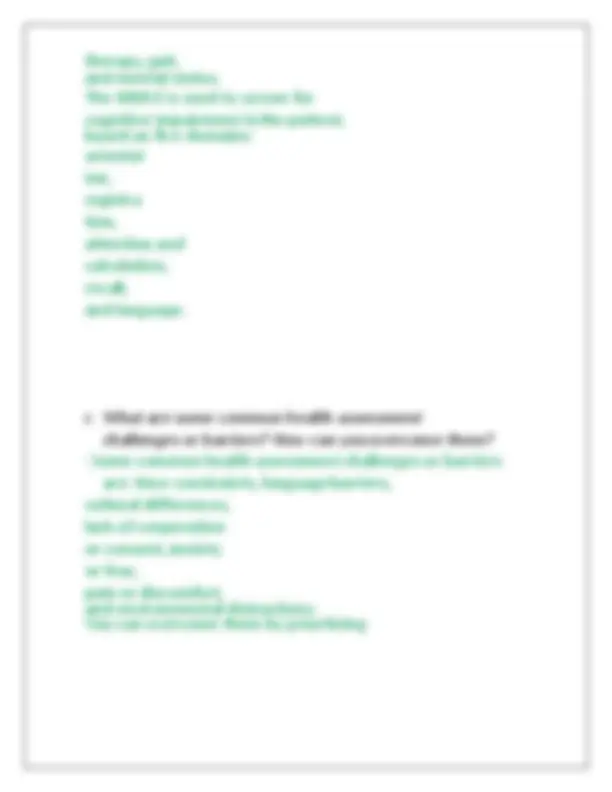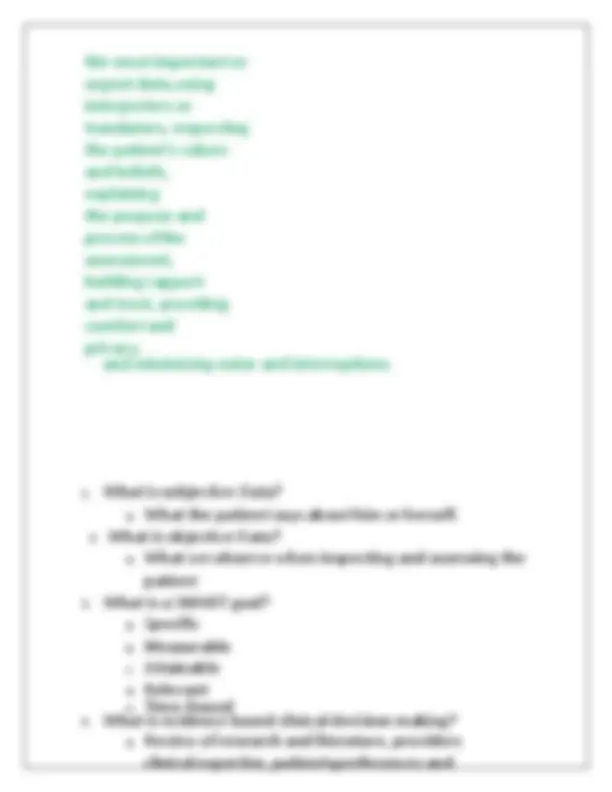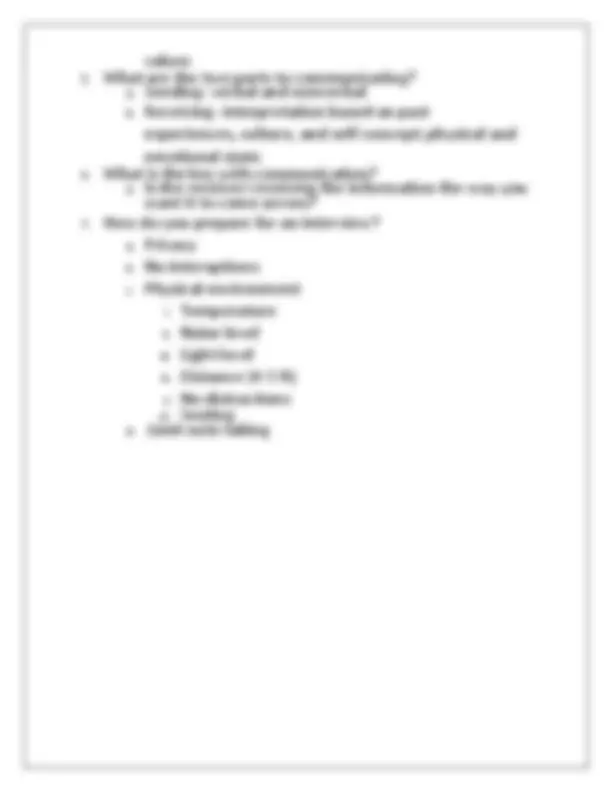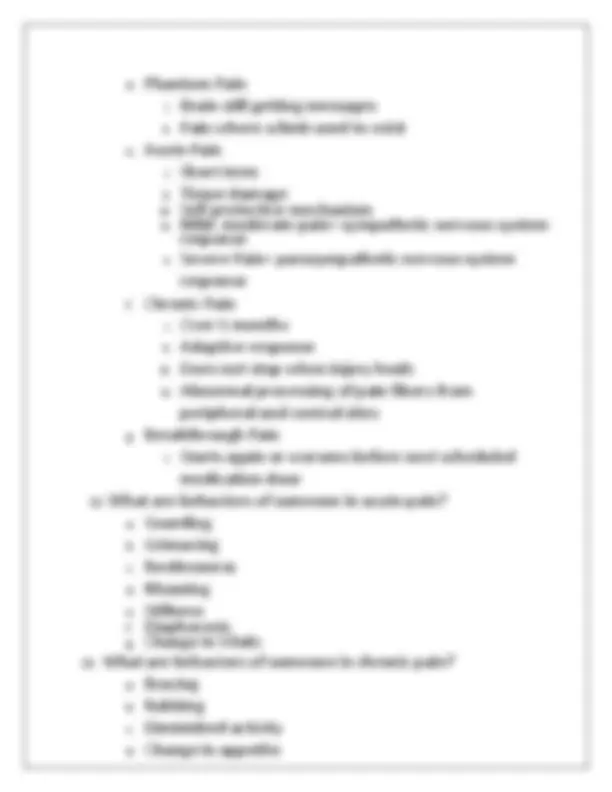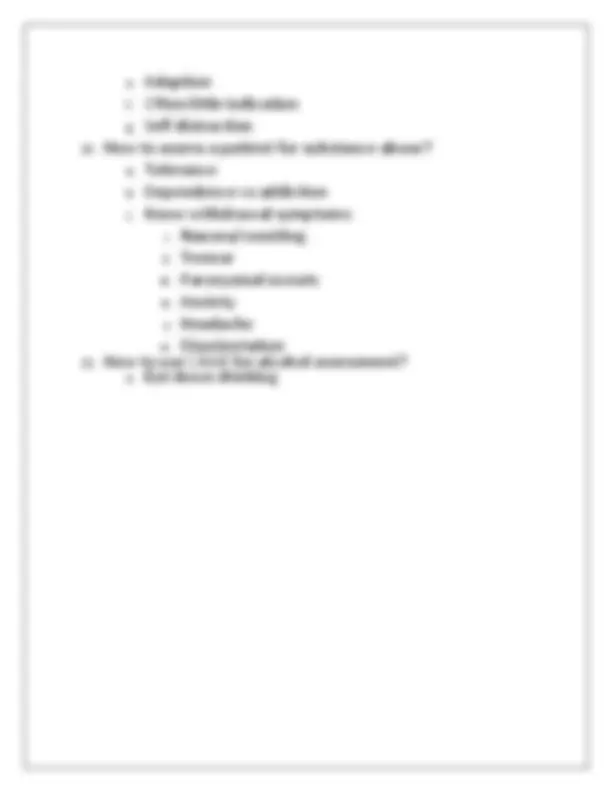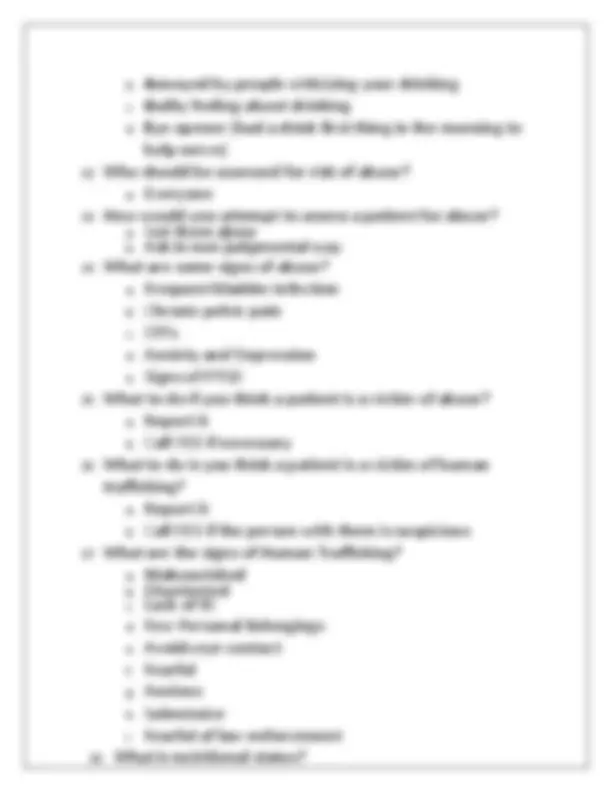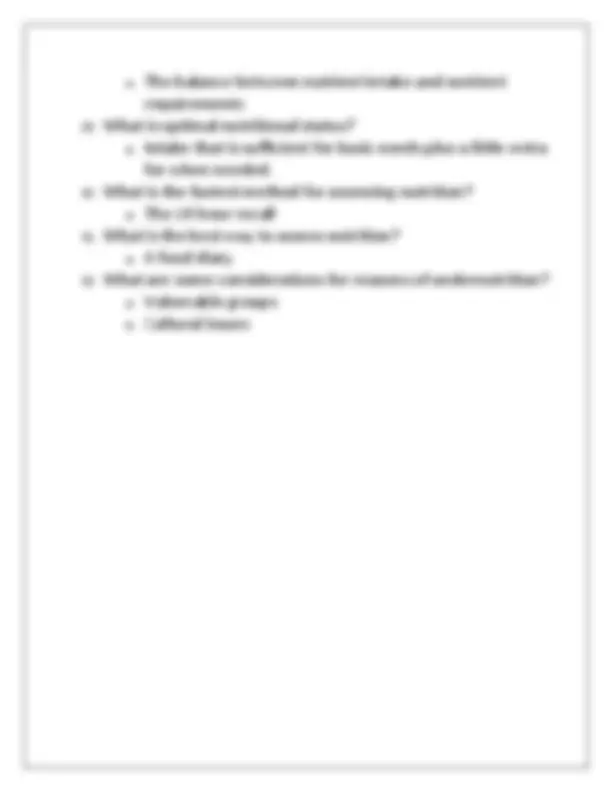Download Nursing Health Assessment and more Exams Nursing in PDF only on Docsity!
NURSING 2410
Health Assessment
ANSWERED
- A nurse is conducting a health history interview with a 65- year-old male patient who complains of chest pain. Which of the following questions is most appropriate to ask first? a) Do you have any history of heart disease or hypertension? b) How would you rate your pain on a scale of 0 to 10? c) When did the pain start and what were you doing at that time? d) What does the pain feel like and where is it located? * Rationale: The most appropriate question to ask first is the one that assesses the quality and location of the pain, as this can help determine the possible cause and severity of the chest pain. The other questions are also important, but they can be asked later.
- A nurse is performing a physical examination on a 25-year- old female patient who is pregnant for the first time. Which of the following findings is normal during pregnancy? a) Increased blood pressure b) Decreased respiratory rate c) Increased heart rate * d) Decreased urinary output Rationale: The normal physiological changes during pregnancy include an increase in heart rate, cardiac output, blood volume, and respiratory rate. Blood pressure usually remains stable or slightly decreases in the first trimester, then increases gradually in the second and third trimesters. Urinary output also increases due to increased renal blood flow and glomerular filtration rate.
- A nurse is assessing the cranial nerves of a 45-year-old male
has a normal weight.
- A nurse is auscultating the lungs of a 55-year-old male patient who smokes a pack of cigarettes per day. Which of the following sounds is most likely to be heard in this patient's lungs? a) Crackles b) Wheezes * c) Stridor d) Pleural friction rub Rationale: Wheezes are high-pitched, musical sounds that are caused by narrowed airways due to inflammation, edema, spasm, or obstruction. They are commonly heard in patients with chronic obstructive pulmonary disease (COPD), asthma, bronchitis, or emphysema, which are associated with smoking. Crackles are crackling or popping sounds that are caused by fluid or secretions in the alveoli or bronchioles. They are commonly heard in patients with pneumonia, heart failure, or pulmonary fibrosis. Stridor is a loud, harsh sound that is caused by upper airway obstruction due to foreign body, tumor, or anaphylaxis. It is usually heard over the trachea or larynx. Pleural friction rub is a grating or rubbing sound that is caused by inflamed pleural surfaces rubbing against each other. It is commonly heard in patients with pleurisy, pneumonia, or pulmonary embolism. B: What are the four main components of a health history? How do they differ from a physical examination?
- The four main components of a health history are: biographical data, reason for seeking care, present health status, and past medical history. They differ from a physical examination in that they are based on the patient's subjective information, while a physical examination is based on the nurse's objective observations and measurements.
- What are some common sources of error or bias in health assessment? How can you minimize them?
- Some common sources of error or bias in health assessment are: stereotyping, personal assumptions, leading questions, false reassurance, and inadequate communication skills. You can minimize them by using open-ended questions, active listening, empathy, cultural sensitivity, and evidence- based practice.
- What are the three levels of prevention in health promotion? Give an example of each.
- The three levels of prevention in health promotion are: primary prevention, secondary prevention, and tertiary prevention. Primary prevention aims to prevent disease or injury before it occurs, such as immunization or smoking cessation. Secondary prevention aims to detect and treat disease or injury early, such as screening tests or antibiotics. Tertiary prevention aims to reduce the
- What are some common tools or instruments used in health assessment? What are their advantages and disadvantages?
- Some common tools or instruments used in health assessment are: stethoscope, thermometer, sphygmomanometer, pulse oximeter, otoscope, ophthalmoscope, tongue depressor, penlight, reflex hammer, tape measure, and scales. Their advantages are that they can provide accurate and objective measurements of various aspects of the patient's health status, such as vital signs, heart sounds, vision, hearing, reflexes, height, and weight. Their disadvantages are that they can be affected by environmental factors, human errors, calibration errors, or malfunctioning.
- What are some key principles of infection control in health assessment? How can you apply them in practice?
- Some key principles of infection control in health assessment are: hand hygiene, personal protective equipment (PPE), standard precautions, transmission- based precautions, and safe disposal of sharps and waste. You can apply them in practice by washing your hands before and after each patient contact, wearing appropriate gloves, masks, gowns, or eye protection depending on the risk of exposure to blood or body fluids, following standard precautions for all patients regardless of their diagnosis or infection status, following transmission-based
precautions for patients with known or suspected infectious diseases that can be transmitted by contact, droplet, or airborne routes, and disposing of sharps and waste in designated containers according to institutional policies.
- What are some common techniques used in physical examination? How do you perform them correctly?
- Some common techniques used in physical examination are: inspection, palpation, percussion, and auscultation. Inspection is the use of sight to observe the patient's appearance, behavior, posture, movement, skin color, lesions, etc. Palpation is the use of touch to feel the patient's skin texture, temperature, moisture, turgor, edema, mass es, pulse s, etc. Percussion is the use of tapping to elicit sounds that reflect the density of underlying structures, such as air-filled, fluid-filled, or solid organs.
plexor with quick and firm strokes for percussion ; and use a stethoscope with earpieces facing forward and a diaphragm or bell depending on the frequency of the sounds for auscultation.
- What are some common health assessment models or frameworks? How do they guide your practice?
- Some common health assessment models or frameworks are: the functional health patterns model, the body systems model, and the head-to-toe model. The functional health patterns model organizes the data into 11 categories that reflect the patient's functional status in various aspects of life, such as health perception, nutrition, activity, sleep, cognition, coping, etc. The body systems model organizes the data into 12 categories that correspond to the major
organ systems of the body, such as cardiovascular, respiratory, gastrointestinal, etc. The head-to-toe model organizes the data in a sequential manner from the head to the toes, covering all the body regions and systems. These models or frameworks guide your practice by providing a systematic and comprehensive approach
therapy, gait, and mental status. The MMSE is used to screen for cognitive impairment in the patient, based on five domains: orientat ion, registra tion, attention and calculation, recall, and language.
- What are some common health assessment challenges or barriers? How can you overcome them?
- Some common health assessment challenges or barriers are: time constraints, language barriers, cultural differences, lack of cooperation or consent, anxiety or fear, pain or discomfort, and environmental distractions. You can overcome them by prioritizing
the most important or urgent data, using interpreters or translators, respecting the patient's values and beliefs, explaining the purpose and process of the assessment, building rapport and trust, providing comfort and privacy, and minimizing noise and interruptions.
- What is subjective Data? a. What the patient says about him or herself.
- What is objective Data? a. What we observe when inspecting and assessing the patient
- What is a SMART goal? a. Specific b. Measurable c. Attainable d. Relevant e. Time-Bound
- What is evidence based clinical decision making? a. Review of research and literature, providers clinical expertise, patients preferences and
- What is a closed ended question? a. A question that allows only a yes or no answer.
- When is a closed ended question used? a. To gain specific information
- What is an opened ended question? a. A question that allows for a narrative answer.
- When is an opened ended question used? a. To hear the pts feelings and opinions b. To develop rapport
- What is a facilitation response? a. Mm-hmm, uh-huh
- What does a silence response do? a. Allow time to think
- What is a reflection response? a. “It’s hard to get up in the morning” “You have difficulty getting the day started”
- What is an empathy response? a. “I can’t do anything for myself anymore.” “It must be difficult not being independent, losing control”
- What are some barriers to communication? a. Lack of interest b. Physical barriers like a curtain, door, computer, pain, room temp. c. Hearing deficit d. Safety e. Psychological barriers- embarrassment, disbelief, anger, fear, grief, fatigue f. Language barrier g. Medical jargon
- What are the types of pain and causes? a. Nociceptive Pain i. Usually acute ii. Starts outside the nervous system iii. From actual potential damages such as fracture or surgery iv. Responsive to anti-inflammatories and opiates b. Neuropathic Pain i. Abnormal processing from injury to nerve fibers or central nervous system ii. Chronic iii. Pt normally feels numbness, tingling, shooting, burning, or phantom pain iv. Poorly responsive to pain meds c. Referred Pain i. Felt at a site different from the organ affected ii. Spinal nerve and brain can not differentiate
e. Adaption f. Often little indication g. Self distraction
- How to assess a patient for substance abuse? a. Tolerance b. Dependence vs addiction c. Know withdrawal symptoms i. Nausea/vomiting ii. Tremor iii. Paroxysmal sweats iv. Anxiety v. Headache vi. Disorientation
- How to use CAGE for alcohol assessment? a. C ut down drinking
b. A nnoyed by people criticizing your drinking c. G uilty feeling about drinking d. E ye opener (had a drink first thing in the morning to help nerve)
- Who should be assessed for risk of abuse? a. Everyone
- How would you attempt to assess a patient for abuse? a. Get them alone b. Ask in non-judgmental way
- What are some signs of abuse? a. Frequent bladder infection b. Chronic pelvic pain c. STI’s d. Anxiety and Depression e. Signs of PTSD
- What to do if you think a patient is a victim of abuse? a. Report it b. Call 911 if necessary
- What to do is you think a patient is a victim of human trafficking? a. Report it b. Call 911 if the person with them is suspicious
- What are the signs of Human Trafficking? a. Malnourished b. Disoriented c. Lack of ID d. Few Personal Belongings e. Avoids eye contact f. Fearful g. Anxious h. Submissive i. Fearful of law enforcement
- What is nutritional status?

